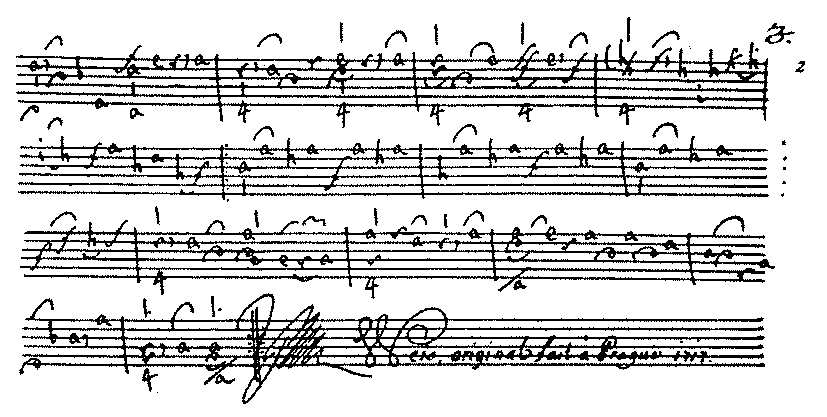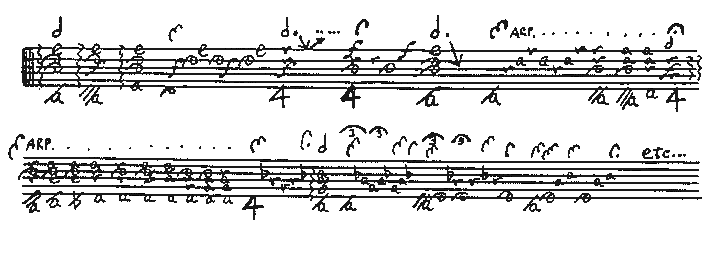© Michel Cardin
The London Manuscript
Solo Sonata 1 in F Major
(Smith-Crawford 1)
The complete and updated version of 'London unveiled' by Michel Cardin can be downloaded as pdf files: 'London unveiled'
This sonata is also found in the Dresden Manuscript. We do find however, fragments of this work in the folios of Vienna and Warsaw, the latter containing three versions for each piece. All versions are similar except for certain left-hand performance indications (slurs). Because of the large number of slurs possible within a given piece, variations inevitably occur from one version to another. It is a rare performer indeed who can resist successfully the urge to modify these articulations to suit his personal technique. While the choice of left-hand articulations has a direct bearing on the musical outcome, it is also true that these decisions fall well within the purview of what is commonly recognised as interpretive ‘personality’. Nevertheless one might attempt to remain as faithful as possible to the London version, as much for reasons of harmonic integrity as for accuracy of slurring.
As a primary source, the first sonata leaves little to guesswork. Four out of the seven movements are signed and dated by the composer with the allemande bearing the inscription in French, “Weiss, originally composed in Prague 1717”.

The London Manuscript, page 3, end of the allemande, Sonata no 1
In addition, the London and Vienna versions are entirely in autograph format. At the beginning of the Praelude which serves also as a starting point for the entire volume, no less than 27 chords are notated in the value of minims. This notational fashion compels various interpretations since standard procedure during this era would require an improvisation on these open rhythmic structures. As a result, I would choose to execute the beginning in a calm, restrained manner to permit the tonal interplay to unfold according to the common practice of the period as explained by the likes of the composer and theorist from Hamburg Johann Mattheson (1681-1764) (the same individual who both denigrated the lute while openly praising Weiss!). The key of F major is thus described as serene, dignified, and understated: “This key is evocative of the most noble of universal sentiments with such ease that it is unnecessary to force the tones. Its magnanimous allure can be best compared to a perfect character in all aspects, redeeming, as the French would say, a ‘bonne grâce.’.”
Seven tranquil, meditative, introductory chords could be then followed by a cycle of arpeggiated vertical sonorities leading to a cadence which capriciously detaches the last of these 27 chords, melting smoothly into the rest of the prelude, retaining its spontaneous atmosphere to the last note.

Example of ornamentation : beginning of the prelude, Sonata no 1
The discretely grandiloquent Allemande is also highly representative of
F major
while the extremely lyric courante (written Cour:) seems to have been
written far from the
actual instrument. While this presents certain performance challenges, the slightly
unidiomatic writing provides a refreshing digression in an otherwise continuous texture.
While scarcely concealing its humourous nature, the highly spirited Bourrée is succeeded by
a sombre sarabande (Sarab: ) in the relative minor. The successive musical waves are
generated by a single rhythmic impulse:
![]() following a descending-ascending
melodic curve that conforms to the shape of the opening of each of the seven movements.
This is indicative of the sense of large-dimensional synthesis and rigorous construction that
characterise so much of the work of Weiss. For further evidence we need only examine the
fundamental structure of the beginning of each movement:
following a descending-ascending
melodic curve that conforms to the shape of the opening of each of the seven movements.
This is indicative of the sense of large-dimensional synthesis and rigorous construction that
characterise so much of the work of Weiss. For further evidence we need only examine the
fundamental structure of the beginning of each movement:

The minuet (Men: ), candid in character, is provided with the dynamic markings of p and f in measures 6 and 9 respectively. This is rather unusual since notated indications of amplitude were generally seen as redundancies, except where specific effects were desired. Furthermore, the range of personal expression available to the Nineteenth-Century composer was not in evidence in the music of this period, the composer not being expected to specify those areas of interpretation, which were very important but left to the discretion of the performer and to the inspiration of each performance. The Gigue ends the sonata in an upbeat mood while irresistibly inviting the listener to dance. Notice the bass leaps which serve to accentuate this dancing atmosphere.
If the sonata has to be considered in its basic form and with the London Manuscript as first reference, it can be stated that this gigue concludes the Sonata no 1 (seven movements). D.A. Smith’s thematic analysis however, acknowledges five more movements to it (even a sixth one could be added, it was either forgotten or rejected by Smith), namely: the two minuets and the gavotte following the gigue in the London ms; a prelude beginning the Vienna version; a chaconne (plus possibly another prelude placed at the end) in one of the Warsaw copies. A performance of the collected sonata in thirteen movements is of course within the realm of the possible, but it is our fear that a sonata of forty minutes duration containing three minuets, not to mention three preludes, could verge on the bizarre. Since these are obviously not additional movements, rather interchangeable replacements, it remains, in our opinion incumbent on each performer to create his or her personal mix while adhering to standard guidelines of piece ordering. At any rate, I will discuss the three London supplements (2 minuets and gavotte) in the next individual pieces’ section.
Copyright © 1998-2006 Laurent
Duroselle, Markus Lutz
A partir du 22 Novembre 1998 les statistiques sont aussi suivies par
![]() Consultez les
Consultez les